
By Aaron Berger, UNL Extension Educator
Early pregnancy detection in replacement heifers or cows is a tool producers can use to increase profit. A webinar titled “Early Pregnancy Diagnosis, a Management and Marketing Tool” (http://go.unl.edu/y7ek)highlights pregnancy diagnosis methods and how they can be utilized. Traditionally, cows and replacement heifers are pregnancy tested in the fall of the year and then non-pregnant cows and cull cows are marketed at that time. This is also historically when cull cow prices tend to be seasonally at their lowest.
Pregnancy can be detected in cows as early as 30 days using ultrasound and blood tests. For cows to be identified as pregnant utilizing the palpation method, cows often need to be at least 35-50 days pregnant. Experience of the person palpating can make a significant difference on how early in this range that pregnancy can be detected. Producers should realize that stress to heifers and cows early in pregnancy can result in loss. Research has shown a pregnancy loss of 1-3.5% when palpation or ultrasound are used for pregnancy diagnosis at 40 – 75 days of gestation.
For cow herds calving January – April, cows can be pregnancy tested in late August and non-pregnant cows sold at that time. Marketing at this time provides two advantages. The first is that cull cow prices in August tend to be 5-10% higher than they are in October or November. The second is that cows that are nursing a calf will typically lose weight from August through the time that calves are weaned due to forage quality having matured and decreasing in its nutritive value.
Selling non-pregnant cows in August when they weigh more and prices are seasonally higher provides the opportunity for producers to capture more value from these cows than leaving the calves on the cows and waiting to pregnancy test at weaning.
Early weaning calves from cows in August will require additional high quality feed and management. However calves at this age are very efficient and the cost of supplemental feed is often not much more expensive than the cost of carrying the pair.
There are several advantages and disadvantages to each of the three methods of pregnancy testing. To see these advantages and disadvantages click on this link (http://go.unl.edu/042q). In some instances using a combination of these methods within a herd may be a valuable tool to accomplish marketing goals.
For producers whose first-calf heifers calve in the January – May time frame, utilizing early pregnancy diagnosis on these heifers as yearlings provides producers the opportunity to timely market non-pregnant heifers. These non-pregnant heifers can be marketed as soon as they are identified or a producer may choose to continue to put weight on them and market later if conditions warrant. These non-pregnant heifers may also be implanted provided that ownership will be retained long enough to see the benefit of the implant.
For producers, leaving bulls with the cows for a long breeding season provides the opportunity to potentially get a higher percentage of cows pregnant. Cows that will calve later than desired can be sold to someone else whose calving season fits that time frame. This can be a way to capture additional value from later calving cows that would otherwise be sold as non-pregnant females in a short breeding season provided feed resource allow.
Non-pregnant heifers and cows as well as cull/bred cows can provide as much as 20% of the gross income to a cow-calf operation on an annual basis. Taking advantage of opportunities to effectively add value to and market these cows through the use of timely pregnancy diagnosis along with an understanding of market seasonality can allow producers to capture more profit from this segment of the cow-calf operation.